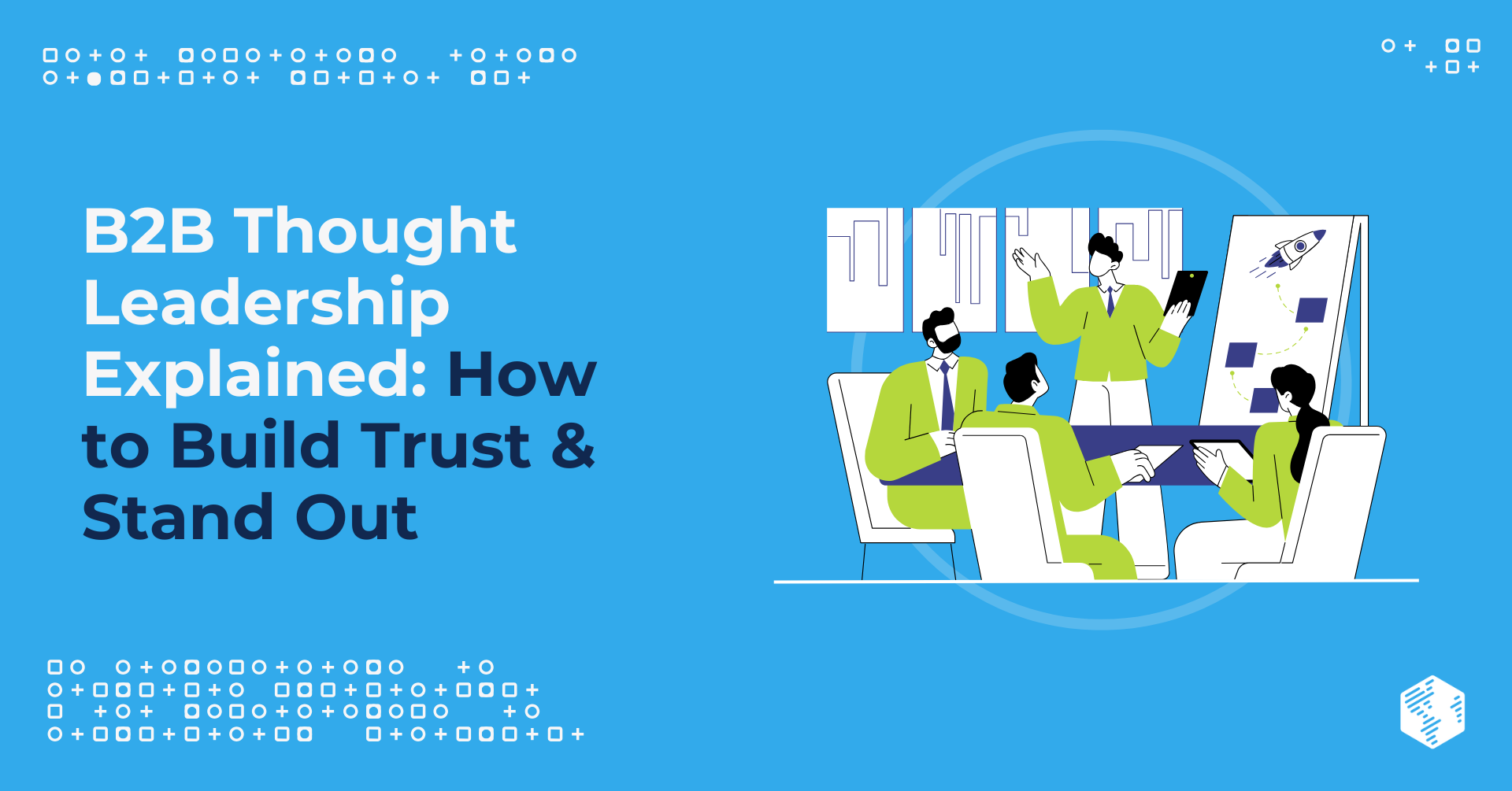Table Of Contents
The term “thought leadership” has become a bit of a buzzword. It’s mentioned everywhere, from blog posts to corporate strategy meetings. And now, it’s so overused that it often feels like companies slap the label on their content without actually thinking through what it means. And as a result, many people misunderstand the concept.
If you’ve heard about B2B thought leadership but aren’t quite sure how to use it to your advantage, don’t worry—you’re not alone. Today, I’ll break down what B2B thought leadership is, why it’s important, and how your company can use it to build credibility, attract customers, and stay ahead of the competition.
Thought Leadership: A Buzzword That Needs Context
Thought leadership is about positioning yourself—or your company—as an expert in a specific area. It involves offering insights, perspectives, and advice that your audience finds valuable.
True thought leadership is about helping others solve problems, think differently, and approach challenges from new angles. When done right, thought leadership builds trust. It helps establish your company as a go-to resource, not only for products or services but also for valuable ideas that can help your audience succeed.
And this isn’t just fluff. It’s backed by real-world data. (I’ll get to those numbers later.)
So, What Exactly Is B2B Thought Leadership?
Now that we’ve clarified the term, let’s talk about what B2B thought leadership is and how it’s different from regular marketing.
B2B decision-makers are usually looking for guidance that can help them solve specific business challenges, improve efficiency, or drive growth. They’re not just looking for surface-level content that tells them why your product is the best thing since sliced bread.
To accommodate this unique audience, B2B thought leadership requires providing content that is insightful, informative, and actionable. It involves sharing the knowledge that can help your audience make smarter decisions.
Thought leadership can be expressed through blog posts, reports, case studies, webinars, or other content formats that dive deep into topics relevant to your industry. The goal? To show your audience that you truly understand their challenges and have valuable insights to share.
It’s about positioning your company as a trusted advisor—not just a vendor.
Why Is Thought Leadership So Important for B2B?
There are plenty of reasons why B2B companies should invest in thought leadership. Here are the key reasons why it’s essential for growing your business in 2025.
Builds Trust & Credibility
In a sea of businesses all trying to sell the same thing, trust is what sets you apart. Decision-makers want to know that you’re not just selling a product or service but that you genuinely have the knowledge and experience to help them succeed. Thought leadership content is a great way to build that trust.

According to the 2024 B2B Thought Leadership Impact Report by Edelman and LinkedIn, 73% of decision-makers agree that a B2B company’s thought leadership content is a more effective and trustworthy basis for assessing its capabilities than its marketing materials or product sheets.
Helps Your Audience Make Informed Decisions
B2B decision-making can be complex and involve multiple stakeholders. Thought leadership helps guide decision-makers by providing useful, relevant information that helps them make better choices.
By offering insights into industry trends, solutions to common problems, and strategies for growth, you become a valuable resource to your audience.
Supports Sales & Marketing
Thought leadership doesn’t just serve your audience—it also supports your sales and marketing efforts. High-quality thought leadership content makes decision-makers more receptive to your outreach. In fact, Edelman and LinkedIn found that 90% of decision-makers and C-suite executives say they’re more likely to engage with sales or marketing teams from companies that consistently produce valuable thought leadership content.

Differentiates Your Brand
It’s tough to stand out in the B2B world. But thought leadership allows you to differentiate your company by demonstrating expertise and offering something your competitors may not. Consistently sharing valuable insights and solutions means you position your company as a leader in your industry.
Creates Long-Term Relationships
Thought leadership helps build long-term relationships with your audience. By providing ongoing value through insights and advice, you build credibility and trust over time, which leads to stronger customer loyalty and, ultimately, better business results.
5 Essential Ingredients of Great B2B Thought Leadership
Not all content qualifies as thought leadership. If you want your thought leadership to make an impact, it needs to meet certain standards. Here are the core ingredients of great B2B thought leadership.
Strong Research & Data
A key component of effective thought leadership is supporting your ideas with solid research and data.
In the B2B world, decision-makers rely heavily on facts and figures to make decisions. Incorporating data-driven insights, case studies, and research reports makes your content not just interesting but also trustworthy. It shows that you’ve done the homework and have the evidence to back up your claims.
Understanding Your Audience’s Business Challenges
To truly provide value, you need to know what’s keeping your audience up at night. What are their biggest pain points? What challenges are they facing in their industry or specific market? Thought leadership content should speak directly to these issues, offering strategies, solutions, and insights that address them head-on.
Actionable Advice
While it’s great to present your audience with new ideas, thought leadership content should also offer practical advice that they can actually apply. Providing concrete guidance, step-by-step plans, or frameworks for solving problems gives your audience something they can put into action, making your content more valuable and useful.
A Unique Perspective
There’s no shortage of content out there, so it’s important to offer something unique. What new angle can you bring to the conversation? Whether you have insider knowledge, a fresh take on an old problem, or a unique solution to a common challenge, your perspective should stand out.
Consistency
Thought leadership is a long-term strategy. It takes more than just creating a single viral post and calling it a day. You need to consistently produce high-quality content over time. By doing so, you will reinforce your expertise and keep your brand top of mind for your audience.
Real Examples of B2B Thought Leadership
Some of the most successful B2B companies have used thought leadership to create a lasting impact on their industry. Let’s go over a few examples.

HubSpot
HubSpot has built its reputation as a thought leader in inbound marketing. The company regularly publishes blogs, research reports, and webinars that offer valuable insights into marketing trends, customer acquisition, and lead generation. Their HubSpot Academy, which offers free courses on marketing and sales, is another great example of thought leadership in action.
McKinsey & Company
As a global consulting firm, McKinsey & Company produces regular research reports and insights into business trends and challenges. Their content not only educates executives but also influences decisions at the highest levels.
Salesforce
Salesforce’s annual State of Sales report and other thought leadership content provide businesses with insights into customer relationship management and the latest trends in sales technology. Their research-driven content is highly regarded by industry leaders and decision-makers.
How to Develop a B2B Thought Leadership Strategy in 2025: 5 Steps to Follow
As we head into 2025, the investment in thought leadership content is expected to increase. According to the Content Marketing Institute, 52% of B2B marketers expect their organizations’ investments in thought leadership content to rise in the coming year. So, if you’re not already embracing this strategy, now is the perfect time to start.

Now that we understand what B2B thought leadership is and why it’s important, let’s outline how to develop a successful strategy for 2025. Follow these key steps to get started.
Identify Your Niche & Expertise
The first step is to figure out where you have the most expertise. Your niche should align with the challenges your audience is facing. Narrowing your focus will help you create content that is more relevant and valuable to your target audience.
Create High-Quality, Data-Driven Content
As mentioned earlier, decision-makers rely on facts and data. To build credibility and trust, your content needs to be backed by research, case studies, and statistics. Use data to back up your insights and provide evidence for your claims.
Create High-Quality, Data-Driven Content
Thought leadership can take many forms. It’s not just about writing blog posts—think about podcasts, videos, webinars, and social media posts as well. Mixing up the formats will help you reach different segments of your audience and keep your content fresh.
Focus on Long-Term Relationships
Don’t just focus on immediate sales. Thought leadership is about nurturing long-term relationships with your audience. It requires consistently providing value, offering guidance, and being a reliable source of information.
Paid Strategies
Paid strategies such as LinkedIn Sponsored Content, InMail, Lead Gen Forms, and Sales Navigator allow you to scale your lead generation efforts and reach highly targeted prospects more efficiently.
Measure & Refine
Once you start producing thought leadership content, track how well it’s performing. Use analytics to measure engagement, lead generation, and overall impact. This type of analysis will help you refine your strategy and continue improving your approach over time.
Conclusion
B2B thought leadership is a powerful tool that can help your company build trust, differentiate itself, and engage with decision-makers. By following the steps outlined in this article, you can develop a thought leadership strategy that helps you stand out, builds credibility, and ultimately drives growth for your business.
At OneIMS, we’re in the business of helping B2B professionals become thought leaders, build their brand, and reach new heights. Schedule a consultation with us today to learn how we can help you grow your company and get the results you’re looking for.





